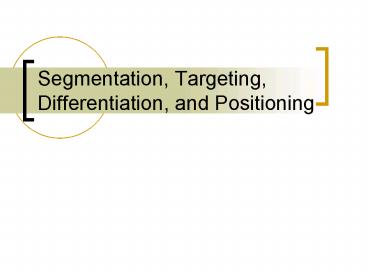Segmentation, Targeting, Differentiation, and Positioning - PowerPoint PPT Presentation
1 / 28
Title:
Segmentation, Targeting, Differentiation, and Positioning
Description:
Sometimes, multiple attributes are combined to form segments ... soft-drink consumers who have little time for sleep, Mountain Dew is the soft ... – PowerPoint PPT presentation
Number of Views:790
Avg rating:3.0/5.0
Title: Segmentation, Targeting, Differentiation, and Positioning
1
Segmentation, Targeting, Differentiation, and
Positioning
2
Segmentation
3
Market Segmentation Strategies
- Traditional Approaches to Market Segmentation
- Mass Marketing
- Differentiated Marketing
- Multisegment Approach
- Market Concentration Approach
- Niche Marketing
4
Bases for SegmentingConsumer Markets
- Behavioral Segmentation
- Segments based on actual behavior or product
usage - Demographic Segmentation
- Segments based on demographic factors (e.g.,
gender, age, income, education, etc.) - Psychographic Segmentation
- Segments based on state-of-mind issues (e.g.,
motives, attitudes, opinions, values, lifestyles,
interests, personality, etc.) - Geographic Segmentation
- Segments based on geographic location
5
Segmenting Consumer Markets
- Sometimes, multiple attributes are combined to
form segments - Multi-attribute segmentation via geoclustering
combines multiple variables to identify smaller,
better-defined target groups - PRIZM Geoclustering system uses demographic,
geographic, lifestyle, and behavioral
characteristics
6
Bases for SegmentingBusiness Markets
- Type of Organization
- Organizational Characteristics
- Benefits Sought or Buying Processes
- Personal and Psychological
- Relationship Intensity
7
Segmenting Business Markets
- Rackman and Vincentis proposed a segmentation
scheme that classifies business buyers into three
groups - Price-oriented customers best served via
transactional selling - Solution-oriented customers best served by means
of consultative selling - Strategic-value customers best served by means
of enterprise selling
8
Segmentation, Marketing Mix, and Targeting
9
Creating the Marketing Mix
PRODUCT
PRICE
PLACE
PROMOTION
10
Goals for Marketing Mix
- Create synergies
- Use resources effectively
- Maintain consistent and differentiated image
- Link to specific marketing goals and objectives
11
Market Share Development Path
Place Strategies
Service Strategies
Price Strategies
Product Strategies
Promotion Strategies
Market Share Index
Service Experience Favorable(0.65)
0.076
Available and Easy to Buy(0.57)
Service Experience Not Favorable(0.35)
0.041
Price Acceptable(0.63)
0.089
Not Available or Easy to Buy(0.43)
Like Product Benefits(0.46)
Price Not Acceptable(0.37)
0.121
Aware of Product(0.71)
Not Attracted to Product(.54)
0.383
Not Aware of Product(0.29)
0.290
1.000
The Market Share index is derived by multiplying
all terms along a given path.
Share Development Path
12
Mass Marketing Strategy
Single Marketing Mix
All Customers in the Market
Undifferentiated
13
Multisegment Strategy
Multiple Marketing Mixes
More Than One Market Segment
Differentiated
14
Market Concentration Strategy
Single Marketing Mix
Focused on a Single Market Segment
Differentiated
15
Niche Marketing Strategy
Focused on a Small Niche Market Segment
Single Marketing Mix
Differentiated
16
Customized Marketing Strategy
Unique Marketing Mixes
Individual Customers
17
Target Marketing Strategies
- Five basic strategies for target market
selection - (1) Single Segment Targeting
- (2) Selective Targeting
- (3) Mass Market Targeting
- (4) Product Specialization
- (5) Market Specialization
18
Basic Target Marketing Strategies
19
Differentiation and Positioning
20
Differentiation and Positioning
- Find ways to distinguish and differentiate the
firms and its product from competitors - Ensure that customers perceive these differences
so your product is positioned accurately in their
minds
21
Differentiation
- Differentiated products feature meaningful and
valuable differences that distinguish the
companys offering from the competition. - Identify what is unique and valuable to customers
- Being the provider of these unique and valuable
benefits leads to competitive advantage
(separation from direct competition)
22
Bases for Differentiation Examples
23
Product Differentiation Examples
24
Positioning
- Two views of positioning
- Ries and Trout products are positioned in the
mind of prospect - Treacy and Wiersema positioning via value
disciplines - Product leader firm
- Operationally excellent firm
- Customer intimate firm
25
Positioning
- Relative to the competition
- Focus on augmented dimensions
- Positioning Strategies
- Strengthen the Current Position
- Repositioning
- Reposition the Competition
26
Positioning and Differentiation
- Positioning statements
- To (target group and need) our (brand) is
(concept) that (point-of-difference) - Example To young, active soft-drink consumers
who have little time for sleep, Mountain Dew is
the soft drink that gives you more energy than
any other brand because it has the highest level
of caffeine.
27
Positioning Map
- A tool used to determine the position of a brand
in the marketplace - Identify set of competing brands.
- Identify important attributes that consumers use
when choosing between brands using qualitative
research (e.g. group discussions). - Conduct quantitative marketing research where
customers score each brand on all the key
attributes. - Plot brands on a two-dimensional map using the
attributes.
28
Using the Positioning Map
- Ask
- What position do you currently own?
- What position do you want to own?
- Whom should you defeat to own that position?
- Do you have the resources to do it?
- Can you persist until you get there?
- Are your tactics supporting the positioning
objective you set? - New entrants
- Spot gaps in the map determine ideal point































